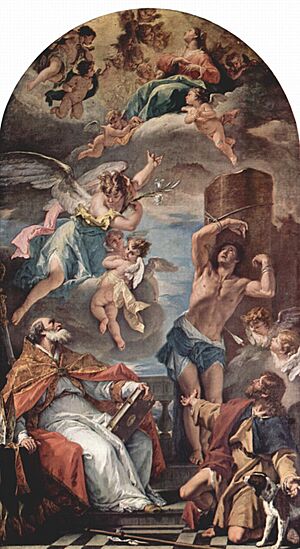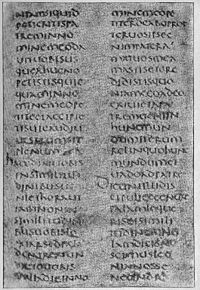Eusebius of Vercelli facts for kids
Quick facts for kids SaintEusebius of Vercelli |
|
|---|---|

The Virgin Mary in Glory with Archangel Gabriel, and Saints Eusebius of Vercelli (seated), Saint Sebastian, and Saint Roch, Sebastiano Ricci.
|
|
| Bishop and Confessor | |
| Born | c. 2 March 283 Sardinia |
| Died | 1 August 371 (aged 88) Vercelli, Piemonte |
| Venerated in | Roman Catholic Church Eastern Orthodox Church |
| Feast | 2 August; 15 December (General Roman Calendar 1602–1728); 16 December (General Roman Calendar 1729–1969) |
| Patronage | Vercelli |
Eusebius of Vercelli was an important saint and bishop who lived a long time ago, from about 283 to 371 AD. He was born in Sardinia, an island that is part of Italy. Eusebius is remembered for strongly defending the idea that Jesus is fully divine, meaning he is God. He stood against a belief called Arianism, which taught that Jesus was not fully God.
Biography
Eusebius was born in Sardinia around the year 283. After his father died for his faith, Eusebius and his mother moved to Rome. There, he became a lector, which is a person who reads from the Bible in church.
He later became the very first bishop in Vercelli, a city in northern Italy. This probably happened in the early to mid-340s. People in Vercelli chose him because they saw how devoted and religious he was.
Eusebius was inspired by the life of Saint Anthony, a famous monk. He started a special community for priests in Vercelli. In this community, the priests lived together, almost like monks. This idea of living together helped other religious leaders, like Gaudentius and Maximus, start similar groups. Eusebius was the first bishop to live this way with his clergy. He worked hard to teach them to be good and enthusiastic about their faith. Because of this, a group called the Canons Regular of St. Augustine see him as one of their founders, along with Augustine of Hippo.
Fighting for Faith
In 354, Pope Liberius asked Eusebius to go to Milan. He went with another bishop, Lucifer of Cagliari. They asked the Emperor Constantius II to hold a meeting of church leaders. This meeting, called a synod, was meant to settle disagreements about Arianism.
The synod was held in Milan in 355. Eusebius attended part of it. However, he refused to agree with those who wanted to condemn Athanasius, another important bishop who also believed Jesus was fully divine. Because Eusebius stood firm in his beliefs, he was sent away from his home, a punishment called "exile."
He was first exiled to a place called Scythopolis in Syria. There, an Arian bishop named Patrophilus watched over him. Eusebius called Patrophilus his "jailer." After that, he was sent to Cappadocia and then to Upper Egypt. During his exile, Eusebius wrote two letters that still exist today.
Return and Continued Work
In Egypt, Eusebius faced many difficulties. He was even dragged through the streets. But he never gave up his Catholic faith. When a new emperor, Julian the Apostate, came to power, the exiled bishops were allowed to return home.
Eusebius stopped in Alexandria on his way back. He attended a synod there in 362, led by Athanasius. This meeting confirmed that the Holy Spirit is also divine. It also agreed to be kind to bishops who had signed Arian beliefs only because they were pressured. However, it decided to punish the leaders of the Arian groups severely.
Eusebius carried the decisions of this synod to Antioch. He hoped to help heal a split in the church there. But he found that Lucifer of Cagliari had already been there. Lucifer had made the split worse by choosing a new bishop for one of the groups without everyone agreeing.
Unable to fix the problem in Antioch, Eusebius continued his journey home. He visited other churches along the way. He wanted to spread and strengthen the true faith. Once he was back in Vercelli in 363, he became a strong leader. Along with Hilary of Poitiers, he worked to defeat Arianism in the Western Church. He was a main opponent of the Arian bishop Auxentius of Milan. Eusebius died in 370 or 371.
Legacy
Even though some people in the Middle Ages called him a martyr, it was more to honor his suffering for his faith. He was not killed for his beliefs, though he endured much hardship. The Roman Catholic Church celebrates his feast day on August 2nd. Vercelli Cathedral is dedicated to him.
Pope Benedict XVI once said that Eusebius taught people to look beyond worldly things. He wanted them to seek a future, heavenly city. This idea helps religious leaders and followers keep their values straight. It reminds them not to follow every new trend or unfair demand from leaders. Eusebius showed that true values come from Jesus Christ, not from emperors.
Works
Eusebius wrote several things during his life.
- Three short letters written by Eusebius still exist today.
- Some people believed he translated a commentary on the Psalms from Greek into Latin. This work is now lost.
- In the cathedral at Vercelli, there is a very old manuscript called the Codex Vercellensis. This is one of the earliest copies of the old Latin Gospels. People once thought Eusebius himself wrote it, but scholars today are not so sure.
See also
 In Spanish: Eusebio de Vercelli para niños
In Spanish: Eusebio de Vercelli para niños


